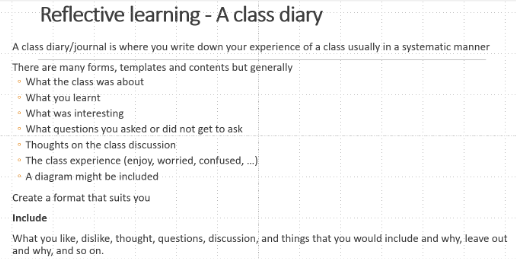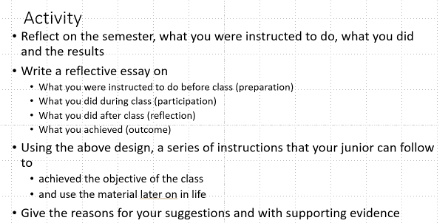
Writing responsibly: how to use reflective practices to navigate ChatGPT

One positive effect of using reflective writing in my classes is that the use of generative AI is low. Reflective writing forces students to think and demonstrate individuality under specific circumstances, which is difficult to replicate using AI transformers such as ChatGPT. If a student can use Chat GPT for reflective writing convincingly, the thinking required means that they understood the exercise and could credibly present a response anyway. For me, the goal of reflective learning is to understand and show that understanding.
I use reflective learning in three ways in my classroom: in journal assignments, rationale for answers and an overall reflective essay. These exercises are helpful for students in expressing their understanding of classwork, thinking process and comprehensive learning. Also, the exercises help benchmarking students’ language skills (most of my students use English as a second language), and learners get opportunities to use language in various ways.
- Collection: AI transformers like ChatGPT are here, so what next?
- What is your academic writing temperament?
- Can we spot AI-written content?
Lecturers who are worried about the use of AI software in their classes might want to try a version of what I have found to be useful.
Use class journals to track attendance and participation
First, I set a class diary (see Figure 1) or journal assignment in most classes. From third-year research methods to first-year study skills, the subject does not matter. The journal helps with tracking attendance and participation. Also, a journal gives the students more opportunities to review class material, write in English and reflect on what is happening in the classroom.
As in many Thai universities, each class is in a three-hour slot once a week. So, at the end of the semester, I usually have 12 to 15 pieces of writing (at 150 to 250 words each) from every student to establish a baseline of their abilities and observe changes over time.
The writing exercise gives students more opportunities to write in English. For the marking rubric, I am relatively lax. Grammatical mistakes, diagrams and images are all allowed, so learners can express themselves. This allowance is not applied in the other class rubrics where standard grammar is expected. Depending on the year, more information is given, along with examples and prompts to stimulate writing.

A class diary clearly shows students’ writing abilities, thinking and understanding. This writing can then be compared with other material written in class. Significant differences might indicate the student got help from someone or somewhere and will prompt a discussion with the student. On several occasions, I have caught students cheating like this because they could not explain the differences.
Ask students to justify their answers
The second approach requires explanations for answers. For my business communication or academic essay writing class, I include writing a rationale for essays, usually accounting for about 20 to 25 per cent of the final mark.
Here, the students need to explain their reasoning, which shows their thinking. Even if students use a writing service, get help or use ChatGPT, they must review the work, think about it and present their understanding. The goal of learning and thinking is thus achieved with a greater appreciation for the topic.

We want students to understand what they are writing about a topic, why it is essential and how the concepts can be used. Writing prompts, such as requiring an explanation, mean that students cannot approach assignments nonchalantly. The bumps in the road jog the brain. Their reasoning doesn’t have to be long (less than one page double-spaced), but it helps with writing.
Give an opportunity to demonstrate overall understanding
Third is a reflective essay overall. I would give an activity like the one below for a class such as business writing and presentation. This essay serves to develop students’ writing skills and lets them express themselves, and I can learn about the course: which parts are effective and what needs to be changed. In such an essay (of 500 words for first-year students and up to 1,000 for third-years), I expect students to use activities from the class and class material; using material from outside the class is difficult in this exercise. References are allowed, but using ChatGPT becomes challenging as the essay is based on a student’s own experiences and the course.

Even if the student uses ChatGPT to correct the essay’s English expression, work is required to ensure that the language makes sense. A lot of reading and understanding of language is suitable for second-language users, who have to work harder on their English.
Assessment workload for reflective writing exercises
Overall, this method of assessment entails a lot more work for the lecturer in terms of reading and giving feedback. However, the net effect outweighs the extra effort. Combined with other classroom-management approaches, reflective writing is a way to recognise students’ individuality. Similar techniques are also useful in business subjects. For example, the question “How has your experience helped in developing a global mindset for growing an international business?” includes a component of applying individuality to theory.
One downside I found was that students might be confused and feel overwhelmed if reflective learning is not used in other classes. The common passive directed approach seems to conflict with active open approach. By interacting with students individually and emphasising the varied approaches to and nature of learning, I relieve some anxieties. Sharing and showing other lecturers the results of what students write in their reflections has helped convey students’ concerns, which can be addressed in other classes. It’s an ongoing effort.
Present situations where AI is of limited use to students
ChatGPT is a relatively new tool, and we all need to learn to use it appropriately. Students, who can be tempted to seek an easy way to complete course assignments, may be prone to misusing the tool. By presenting situations where AI is of limited use, students are forced to think and consider their own tools more. For example, a handsaw might be good for cutting wood planks but will be of little use in cutting down a tree.
Please note that I am not an English teacher. My doctorate is in management, and I spent most of my professional life as a geologist. However, as a lecturer, I think getting students to think, show their understanding and use tools appropriately is vital. So, while not foolproof nor the only approach available, I am sharing what works for me.
Teachers have a wide range of tools to get students to think. Some older, more established methods complement technology and might even help with technology use. So try it and let us know the results.
Mariano “Mario” Carrera is a lecturer in the International College at King Mongkut’s University of Technology North Bangkok, Thailand.
If you would like advice and insight from academics and university staff delivered direct to your inbox each week, sign up for the Campus newsletter.


